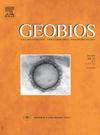Salbatore II的下颌骨:伊比利亚半岛北部一个新的Ursus deningeri遗址
IF 1.6
4区 地球科学
Q2 PALEONTOLOGY
引用次数: 0
摘要
deningeri熊和spelaeus sensu lato熊是属于第四纪标志性洞穴熊谱系的时间物种。他们从早期晚期到中更新世晚期居住在伊比利亚。在这里,我们描述了一个完整的熊下颌骨从Salbatore II洞穴(巴斯克地区)恢复。为了评估它的分类,我们将它与其他欧洲更新世洞穴熊和棕熊进行了比较。对其形态进行了比较,并使用传统和三维几何形态计量学分析。下颌骨与穴居熊有几个形态上的相似之处,如高的躯干和深的咬窝。然而,冠状突向后倾斜,翼状突尖,p1和p3存在。这些特征通常与丹宁葛兰和阿克兰有关。计量分析表明,Salbatore II符合洞穴熊的变化,一旦考虑到体型,与棕熊的重叠最小。然而,几何形态分析表明Salbatore II与U. arctos相似,但属于U. deningeri变异。从整体大小和形态特征来看,Salbatore II具有许多与U. deningeri相似的祖先特征,表明其最晚出现在中更新世,这一年代在坎塔布连地区很少有记录。本文章由计算机程序翻译,如有差异,请以英文原文为准。
The mandible of Salbatore II: A new Ursus deningeri site in the northern Iberian Peninsula
Ursus deningeri, together with Ursus spelaeus sensu lato, are chronospecies that belong to the Quaternary iconic cave bear lineage. They inhabited Iberia from the late Early to the late Middle Pleistocene. Here we describe a complete bear mandible recovered from Salbatore II cave (Basque Country). To assess its taxonomy, we compared it with other European Pleistocene cave and brown bears. Comparisons were made concerning its morphology and using both traditional and 3D geometric morphometrics analyses. The mandible has several morphological similarities with the cave bears such as a high corpus and deep masseter fossa. However, it exhibits a coronoid process that leans backwards, a pointed pterygoid process, and the p1 and p3 are present. These are characteristics customarily associated with U. deningeri and U. arctos. Metric analyses show that Salbatore II fits within the cave bear variation, with a minimum overlap with brown bears once size is accounted for. However, geometric morphometric analyses show that Salbatore II is similar to U. arctos, but within U. deningeri variation. Based on the overall size and the morphological characteristics, Salbatore II displays U. deningeri affinities with many ancestral characteristics, suggesting a minimum mid-Middle Pleistocene age, a chronology rarely recorded in the Cantabrian region.
求助全文
通过发布文献求助,成功后即可免费获取论文全文。
去求助
来源期刊

Geobios
地学-古生物学
CiteScore
3.30
自引率
6.20%
发文量
28
审稿时长
6-12 weeks
期刊介绍:
Geobios publishes bimonthly in English original peer-reviewed articles of international interest in any area of paleontology, paleobiology, paleoecology, paleobiogeography, (bio)stratigraphy and biogeochemistry. All taxonomic groups are treated, including microfossils, invertebrates, plants, vertebrates and ichnofossils.
Geobios welcomes descriptive papers based on original material (e.g. large Systematic Paleontology works), as well as more analytically and/or methodologically oriented papers, provided they offer strong and significant biochronological/biostratigraphical, paleobiogeographical, paleobiological and/or phylogenetic new insights and perspectices. A high priority level is given to synchronic and/or diachronic studies based on multi- or inter-disciplinary approaches mixing various fields of Earth and Life Sciences. Works based on extant data are also considered, provided they offer significant insights into geological-time studies.
 求助内容:
求助内容: 应助结果提醒方式:
应助结果提醒方式:


